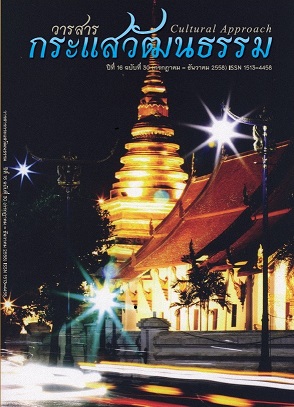Zhuang Language: Chinese Scholars' Perspective on Tai Language in China
Main Article Content
Abstract
Chinese scholars have classified Zhuang language in Sino – Tibetan language family, Zhuang-Dong language branch. In this branch, there are three language members who have settled in Chinanamely Dai, Buyi, and Zhuang. The three languages are most closely with Thai language. This article aims to present linguistic data on the minority tribe in China, Zhuang. As perceived by Chinese scholars, this article will present two main issues: 1) Naming and resident and 2) linguistic data which consists of (1) Phonology (2) wording system (3) Grammar (4) Borrow words (5) Dialects and (6) Characters. By investigating, it revealed that although there are many Thai researchers who work on Zhuang Dictionaries, still lacking in composed of Chinese Scholars’ Perspective. This article will contribute information for Thai scholar who would like to conduct further research related to the topic in the future.
Article Details
How to Cite
Sodsonghrit, M. (2015). Zhuang Language: Chinese Scholars’ Perspective on Tai Language in China. Journal of Cultural Approach, 16(30), 68–81. Retrieved from https://so02.tci-thaijo.org/index.php/cultural_approach/article/view/58455
Section
Academic Article
Proposed Creative Commons Copyright Notices
1. Proposed Policy for Journals That Offer Open Access
Authors who publish with this journal agree to the following terms:
- Authors retain copyright and grant the journal right of first publication with the work simultaneously licensed under a Creative Commons Attribution License that allows others to share the work with an acknowledgement of the work's authorship and initial publication in this journal.
- Authors are able to enter into separate, additional contractual arrangements for the non-exclusive distribution of the journal's published version of the work (e.g., post it to an institutional repository or publish it in a book), with an acknowledgement of its initial publication in this journal.
- Authors are permitted and encouraged to post their work online (e.g., in institutional repositories or on their website) prior to and during the submission process, as it can lead to productive exchanges, as well as earlier and greater citation of published work (See The Effect of Open Access).
Proposed Policy for Journals That Offer Delayed Open Access
Authors who publish with this journal agree to the following terms:
- Authors retain copyright and grant the journal right of first publication, with the work [SPECIFY PERIOD OF TIME] after publication simultaneously licensed under a Creative Commons Attribution License that allows others to share the work with an acknowledgement of the work's authorship and initial publication in this journal.
- Authors are able to enter into separate, additional contractual arrangements for the non-exclusive distribution of the journal's published version of the work (e.g., post it to an institutional repository or publish it in a book), with an acknowledgement of its initial publication in this journal.
- Authors are permitted and encouraged to post their work online (e.g., in institutional repositories or on their website) prior to and during the submission process, as it can lead to productive exchanges, as well as earlier and greater citation of published work (See The Effect of Open Access).
References
[1] เธียรชัย เอี่ยมวรเมธ. (2541). พจนานุกรมจีน-ไทย. (พิมพ์ครั้งที่ 5). กรุงเทพฯ: อักษรพิทยา.
[2] ปราณี กุละวณิชย์. (2535). พจนานุกรมจ้วงใต้ – ไทย. กรุงเทพฯ: จุฬาลงกรณ์มหาวิทยาลัย.
[3] เมชฌ สอดส่องกฤษ. (2552). เสียงปฏิภาค /r/,/k/,/kh/ และเสียงปฏิภาคอื่นๆ: หลักฐานความสัมพันธ์ของภาษาจีนกับภาษาไทยในฐานะภาษาร่วมตระกูล. วารสารมนุษยศาสตร์ปริทรรศน์. 31 (ประจำภาคเรียนที่ 2 ปี การศึกษา 2552).
[4] เมชฌ สอดส่องกฤษ. (2553). การศึกษาวิเคราะห์ทางภาษาศาสตร์เชิงประวัติศาสตร์ของภาษาตระกูลไท-จีนเรื่อง ความสัมพันธ์ของเสียง / h / ในภาษาไทยถิ่นอีสานกับเสียง / h / ในภาษาจีน. วารสารศิลปศาสตร์. 2(2), 68-90.
[5] เมชฌ สอดส่องกฤษ. (2554). การศึกษาทางภาษาศาสตร์เชิงประวัติศาสตร์เรื่อง คำศัพท์ร่วมเชื้อสายไท-จีนในภาษาไทยถิ่นอีสาน. The Journal of the Faculty of Liberal Arts. 7(2), 125-149.
[6] เมชฌ สอดส่องกฤษ. (2554). สารานุกรมชนกลุ่มน้อยในประเทศสาธารณรัฐประชาชนจีน. อุบลราชธานี:โรงพิมพ์มหาวิทยาลัยอุบลราชธานี.
[7] เมชฌ สอดส่องกฤษ. (2557). ภาษาปู้อี : ภาษาที่ใกล้ชิดกับภาษาไทยในประเทศจีน. วารสารกระแสวัฒนธรรม.28(15), 67-76.
[8] เมชฌ สอดส่องกฤษ และฉวีวรรณ ว่องเจริญกุล. (2557). ชนกลุ่มน้อยเผ่าไต: พี่น้องเผ่าไทในสิบสองปันนาสาธารณรัฐประชาชนจีน. วารสารกระแสวัฒนธรรม. 27(15), 51-64.
[9] สมทรง บุรุษพัฒน์ และคณะ. (2539). ภาษาและวัฒนธรรมของชนชาติกัม-ไท (จ้วง-ต้ง): รายการคำศัพท์. กรุงเทพฯ: บริษัทสหธรรมิกจำกัด.
[10] สมทรง บุรุษพัฒน์ และฉินเชียวหาง. (2549). พจนานุกรมจ้วงเหนือ-จีน-ไทย-อังกฤษ. กรุงเทพฯ: เอกพิมพ์ไท.
[11] สุริยา รัตนกุล. (2548). นานาภาษาในเอเชียอาคเนย์: ภาษาตระกูลไท. กรุงเทพฯ: สหธรรมิก.
[12] Somsong Burusphat and Qin Xiaohang. (2012). Zhuang Word Structure. Journal of Chinese Linguistics. 40(1), 56-83.
[13] 韦庆稳,覃国生. (1980). 《壮语简志》. 北京:民族出版社. (เหว่ยชิ่งเหวิ่น และถานกว๋อเซิง. (1980). ปริทรรศน์ภาษาจ้วง. ปักกิ่ง: สำนักพิมพ์ชาติพันธุ์) องค์ความรู้ภูมิปัญญากลุ่มชาติพันธุ์ภาคกลาง. (ม.ป.ป.). วันที่ค้นข้อมูล 15 มีนาคม 2558, เว็บไซต์
https://www.thaiethnicity.com
[14] 波涛魔涯,笔名. (2007).《浅议傣史溯源》(新华网) 搜索日期.2015年3月10日. (Botaomoya (นามปากกา). (2550). เสวนาการสืบสาวประวัติศาสตร์ไต. วันที่ค้นข้อมูล 10 มีนาคม 2558, จาก Xinhua Wang เว็บไซต์ https://bncdcywm.home.news.cn/blog/a/010100017BB5012049E7FBFE .html)
[2] ปราณี กุละวณิชย์. (2535). พจนานุกรมจ้วงใต้ – ไทย. กรุงเทพฯ: จุฬาลงกรณ์มหาวิทยาลัย.
[3] เมชฌ สอดส่องกฤษ. (2552). เสียงปฏิภาค /r/,/k/,/kh/ และเสียงปฏิภาคอื่นๆ: หลักฐานความสัมพันธ์ของภาษาจีนกับภาษาไทยในฐานะภาษาร่วมตระกูล. วารสารมนุษยศาสตร์ปริทรรศน์. 31 (ประจำภาคเรียนที่ 2 ปี การศึกษา 2552).
[4] เมชฌ สอดส่องกฤษ. (2553). การศึกษาวิเคราะห์ทางภาษาศาสตร์เชิงประวัติศาสตร์ของภาษาตระกูลไท-จีนเรื่อง ความสัมพันธ์ของเสียง / h / ในภาษาไทยถิ่นอีสานกับเสียง / h / ในภาษาจีน. วารสารศิลปศาสตร์. 2(2), 68-90.
[5] เมชฌ สอดส่องกฤษ. (2554). การศึกษาทางภาษาศาสตร์เชิงประวัติศาสตร์เรื่อง คำศัพท์ร่วมเชื้อสายไท-จีนในภาษาไทยถิ่นอีสาน. The Journal of the Faculty of Liberal Arts. 7(2), 125-149.
[6] เมชฌ สอดส่องกฤษ. (2554). สารานุกรมชนกลุ่มน้อยในประเทศสาธารณรัฐประชาชนจีน. อุบลราชธานี:โรงพิมพ์มหาวิทยาลัยอุบลราชธานี.
[7] เมชฌ สอดส่องกฤษ. (2557). ภาษาปู้อี : ภาษาที่ใกล้ชิดกับภาษาไทยในประเทศจีน. วารสารกระแสวัฒนธรรม.28(15), 67-76.
[8] เมชฌ สอดส่องกฤษ และฉวีวรรณ ว่องเจริญกุล. (2557). ชนกลุ่มน้อยเผ่าไต: พี่น้องเผ่าไทในสิบสองปันนาสาธารณรัฐประชาชนจีน. วารสารกระแสวัฒนธรรม. 27(15), 51-64.
[9] สมทรง บุรุษพัฒน์ และคณะ. (2539). ภาษาและวัฒนธรรมของชนชาติกัม-ไท (จ้วง-ต้ง): รายการคำศัพท์. กรุงเทพฯ: บริษัทสหธรรมิกจำกัด.
[10] สมทรง บุรุษพัฒน์ และฉินเชียวหาง. (2549). พจนานุกรมจ้วงเหนือ-จีน-ไทย-อังกฤษ. กรุงเทพฯ: เอกพิมพ์ไท.
[11] สุริยา รัตนกุล. (2548). นานาภาษาในเอเชียอาคเนย์: ภาษาตระกูลไท. กรุงเทพฯ: สหธรรมิก.
[12] Somsong Burusphat and Qin Xiaohang. (2012). Zhuang Word Structure. Journal of Chinese Linguistics. 40(1), 56-83.
[13] 韦庆稳,覃国生. (1980). 《壮语简志》. 北京:民族出版社. (เหว่ยชิ่งเหวิ่น และถานกว๋อเซิง. (1980). ปริทรรศน์ภาษาจ้วง. ปักกิ่ง: สำนักพิมพ์ชาติพันธุ์) องค์ความรู้ภูมิปัญญากลุ่มชาติพันธุ์ภาคกลาง. (ม.ป.ป.). วันที่ค้นข้อมูล 15 มีนาคม 2558, เว็บไซต์
https://www.thaiethnicity.com
[14] 波涛魔涯,笔名. (2007).《浅议傣史溯源》(新华网) 搜索日期.2015年3月10日. (Botaomoya (นามปากกา). (2550). เสวนาการสืบสาวประวัติศาสตร์ไต. วันที่ค้นข้อมูล 10 มีนาคม 2558, จาก Xinhua Wang เว็บไซต์ https://bncdcywm.home.news.cn/blog/a/010100017BB5012049E7FBFE .html)

